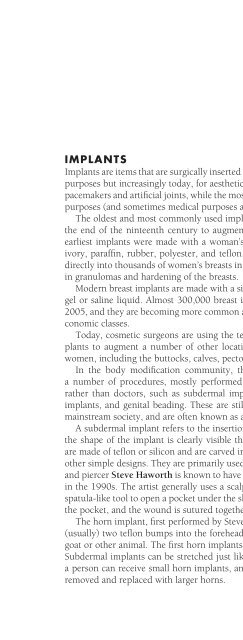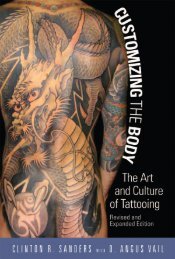- Page 2:
Encyclopedia of Body Adornment
- Page 8:
Library of Congress Cataloging-in-P
- Page 14:
Acupuncture Alliance of Professiona
- Page 18:
Scarification Self-Mortification Se
- Page 24:
xii GUIDE TO RELATED TOPICS India I
- Page 28:
xiv GUIDE TO RELATED TOPICS Interse
- Page 32:
xvi PREFACE Nevertheless, all attem
- Page 36:
xviii INTRODUCTION marked onto even
- Page 40:
xx INTRODUCTION or mutilation. Extr
- Page 44:
2 ACUPUNCTURE as the early communis
- Page 48:
4 AMERICAN TATTOOING there is incre
- Page 52:
6 AMERICAN TATTOOING learned to tat
- Page 56:
8 AMPUTATION use a wide range of to
- Page 60:
10 ANIMAL BRANDING An older style o
- Page 64:
12 ANIMALITY Branding calves on rou
- Page 68:
14 ANIMAL SURGICAL PROCEDURES youth
- Page 72:
16 ANOREXIA AND BULIMIA Tattoos hav
- Page 76:
18 ASSOCIATION OF PROFESSIONAL PIER
- Page 80:
20 AUSTRALIA See also: Criminality;
- Page 86:
B BAKHTIN, MIKHAIL Mikhail Bakhtin
- Page 90:
BARNUM, P. T. 25 size is decreased
- Page 94:
practices such as erotic spanking,
- Page 98:
cultures. Because of this, some Asi
- Page 102:
BIO-POWER 31 used the tattoo as a f
- Page 106:
BODYBUILDING 33 BMEZine’s focus i
- Page 110:
BODY DYSMORPHIC DISORDER 35 control
- Page 114:
BODY HAIR 37 bare-chested as a sign
- Page 118:
BODY PAINTING 39 colors include whi
- Page 122:
BODY PIERCING 41 decorations contin
- Page 126:
BORNEO 43 Play piercing refers to t
- Page 130:
BRANDING 45 members of the working
- Page 134:
BRAZIL 47 In fraternities, branding
- Page 138:
BREAST AUGMENTATION AND REDUCTION 4
- Page 142:
BROADBENT, BETTY 51 The insertion o
- Page 146:
See also: Freak Shows; Tattooed Att
- Page 152:
56 CASTRATION men. Historically, th
- Page 156:
58 CELTS Some in the extreme body m
- Page 160:
60 CHINA finely shaded, “photo re
- Page 164:
62 CHRISTIANITY the Jewish Torah. H
- Page 168:
64 CIRCUMCISION 1992; Jones, C. P.
- Page 172:
66 CIRCUMCISION is laid out in the
- Page 176:
68 CIRCUS the Circus Maximus, but t
- Page 180:
70 CLASS AND STATUS the criminal ta
- Page 184:
72 CLITORIDECTOMY France or the Uni
- Page 188:
74 COLLINS, SAILOR JERRY Internatio
- Page 192:
76 CONTEMPORARY TATTOOING using the
- Page 196:
78 COOK, CAPTAIN JAMES Cook’s sec
- Page 200:
80 CORSETS stiffening. The corset w
- Page 204:
82 COSMETICS dental implants and br
- Page 208:
84 COSMETIC SURGERY The lips are an
- Page 212:
86 COSMETIC TATTOOING Inscription:
- Page 216:
88 CROSS-DRESSERS propensity toward
- Page 222:
D DANCES SACRED AND PROFANE Dances
- Page 226:
E EAR PIERCING Ear piercing refers
- Page 230:
EAR PIERCING 95 And dangling earrin
- Page 234:
EAR SPOOLS AND EARPLUGS 97 EAR SPOO
- Page 238:
EAR STRETCHING 99 then pushed throu
- Page 242:
EGYPT The ancient Egyptians, and es
- Page 246:
ENCUMBERMENTS 103 reshape the body
- Page 250:
ENGLAND 105 Europe (the word “tat
- Page 254:
See also: Circus; Freak Shows; Frea
- Page 258:
F FACIAL HAIR Facial hair refers to
- Page 262:
FACIAL PIERCING 111 piercings. Toda
- Page 266:
FINGERNAILS 113 taboo against them.
- Page 270:
and men enjoy seeing men with long
- Page 274:
FOOT BINDING 117 Other results incl
- Page 278:
FREAK SHOWS 119 Because tattoos are
- Page 282:
FREAK SHOWS 121 attendance at the f
- Page 286:
FREAKS 123 The first freak to be di
- Page 290:
G GANG MEMBERS Because tattoos have
- Page 294:
GENDER 127 often than not, we find
- Page 298: GENETIC ENGINEERING 129 forcing men
- Page 302: GENITAL MUTILATION 131 from the cor
- Page 306: GENITAL TATTOOING 133 piercings, wh
- Page 310: THE GREAT OMI 135 One of Omi’s fi
- Page 314: See also: Criminality; Christianity
- Page 320: 140 HAIRSTYLES Tonga, it was custom
- Page 324: 142 HAIRSTYLES crossing festival, d
- Page 328: 144 HAIR TREATMENTS Humans have, th
- Page 332: 146 HAWAII In 1982, Hardy, along wi
- Page 336: 148 HAWORTH, STEVE Tattooing in Haw
- Page 340: 150 HEALTH ISSUES The ancient Egypt
- Page 344: 152 HENNA pierced skin, or certain
- Page 352: 156 IMPLANTS A transdermal implant
- Page 356: 158 INDIA were tattooed prior to ma
- Page 360: 160 INTERSEXUALITY sewn together, i
- Page 364: 162 INUIT like most societies, is s
- Page 368: 164 ISLAM back to Pakistan told the
- Page 374: J JAPAN Not only is Japanese tattoo
- Page 378: It was also this same time period,
- Page 382: JEWELRY 171 herbs or other magical
- Page 386: JUDAISM 173 tattooed Jew can still
- Page 392: 176 LABRETS a sign of status. High-
- Page 396: 178 LEGISLATION AND REGULATION her
- Page 400:
180 LIP PLATES Lip plates are gener
- Page 404:
182 MAKEUP tattooed onto the knuckl
- Page 408:
184 MARSHALL ISLANDS still get tatt
- Page 412:
186 MESO-AMERICA skin, as in the ca
- Page 416:
188 MILITARY TATTOOS MILITARY TATTO
- Page 420:
190 MODERN PRIMITIVES Certain parts
- Page 424:
192 MODERN PRIMITIVES Further Readi
- Page 428:
194 MOKO Europeans. Evidently, it a
- Page 432:
196 MUSAFAR, FAKIR transformation,
- Page 436:
198 NATIVE AMERICANS Some tribes on
- Page 440:
200 NEW GUINEA Great Goddess. This
- Page 444:
202 NEW ZEALAND See also: Body Pain
- Page 448:
204 NOSE PIERCING My piercings help
- Page 452:
206 NOSE PIERCING Septum piercing w
- Page 456:
208 ORAL PIERCING Today, obesity ac
- Page 460:
210 ORCHIECTOMY be seen as decorati
- Page 464:
212 PAIN menstruation. Among the Tl
- Page 468:
214 PENIS PIERCING Samoan Pe’a ta
- Page 472:
216 PFIQ See also: Cosmetic Surgery
- Page 476:
218 PIERCING PIERCING The practice
- Page 480:
220 PRIMITIVISM Modern primitives,
- Page 484:
222 PRISON TATTOOING Prison tattoos
- Page 488:
224 PRISON TATTOOING man may wear a
- Page 492:
226 PRISON TATTOOING then serve to
- Page 496:
228 PUNK staples, and other sharp i
- Page 500:
230 ROMAN Each one of my tattoos wa
- Page 504:
232 ROMAN Phrases are also often ta
- Page 508:
234 SCALPELLING each part of the ta
- Page 512:
236 SCARIFICATION Among the Nuba of
- Page 516:
238 SELF-MORTIFICATION pieces of sk
- Page 520:
240 SEX REASSIGNMENT SURGERY pain,
- Page 524:
242 SIDESHOW SIDESHOW See Freak Sho
- Page 528:
244 SLAVERY Race and Affluence: An
- Page 532:
246 STALKING CAT ears, tongue, and
- Page 536:
248 STRETCHING of ways of stretchin
- Page 540:
250 SUPER/SUBINCISION SUPER/SUBINCI
- Page 544:
252 SUSPENSIONS Further Reading: ww
- Page 550:
T TAHITI Tahiti is a Polynesian isl
- Page 554:
TATTOO COMMUNITY 257 Sunbathing bec
- Page 558:
TATTOOED ATTRACTIONS 259 the develo
- Page 562:
TATTOOED ATTRACTIONS 261 Hildebrand
- Page 566:
TATTOOED NATIVES 263 James O’Conn
- Page 570:
TATTOOING 265 way for human odditie
- Page 574:
TATTOO MAGAZINES 267 While tattooin
- Page 578:
TATTOO MAGAZINES 269 both for tatto
- Page 582:
TATTOO REMOVAL 271 the stands calle
- Page 586:
TATTOO SHOWS 273 their wares, and t
- Page 590:
TATTOO TECHNOLOGY 275 For many indi
- Page 594:
THAILAND 277 Hearts and True Love:
- Page 598:
TIGHTLACING See Corsets TONGA 279 T
- Page 602:
TORTURE 281 Naked woman being tortu
- Page 606:
TRANSSEXUALS 283 Hijras cannot repr
- Page 610:
TREPANATION 285 women can so easily
- Page 614:
TRIBALISM 287 William H. Egberts ex
- Page 618:
TUTTLE, LYLE 289 at that time were
- Page 622:
W WAGNER, CHARLIE Professor Charles
- Page 626:
WILDENSTEIN, JOCELYN 293 WILDENSTEI
- Page 632:
296 YAKUZA the men often remove the
- Page 636:
298 ZEIS, MILTON See also: Scarific
- Page 642:
MAGAZINES Body Painting Magazine 14
- Page 646:
MUSEUMS Amsterdam Tattoo Museum htt
- Page 652:
306 BIBLIOGRAPHY Balsamo, Anne. “
- Page 656:
308 BIBLIOGRAPHY Davis, Kathy. Resh
- Page 660:
310 BIBLIOGRAPHY Gremillion, Helen.
- Page 664:
312 BIBLIOGRAPHY Lang, Sabine, Sue-
- Page 668:
314 BIBLIOGRAPHY Pitts, Victoria.
- Page 672:
316 BIBLIOGRAPHY Sullivan, Deborah.
- Page 678:
Acupuncture, 1-3, 60-61, 163 Afghan
- Page 682:
Ear spools and ear plugs, 48, 69, 9
- Page 686:
Lazonga, Vyvyn, 177-78 Leather comm
- Page 690:
Salmon, Bill, 146 Samoa, 75, 133, 1
- Page 694:
About the Author MARGO DEMELLO has
- Page 700:
Sacred heart shoulder tattoo. Jeff
- Page 704:
Skull on inner bicep. Jeff Hayes of
- Page 708:
Cartoon bunnies on woman’s chest.
- Page 712:
Photo-realistic tattoo of Albert Ei



